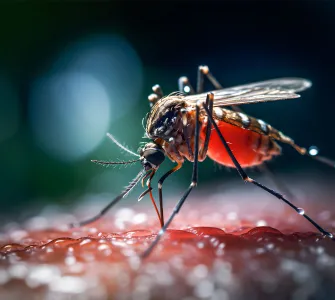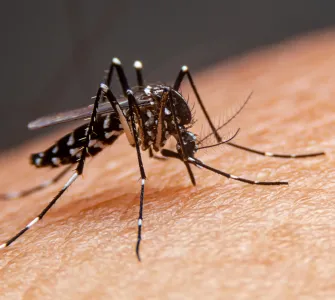Dengue: 5 quick facts


Dengue is often referred to as ‘break-bone’ fever for a reason
It is important to recognize that many dengue infections are asymptomatic or produce only mild illness.1 One in 4 people infected with this disease may experience symptoms which are usually short-lived, lasting for 2–7 days.1,2 People will most commonly have a fever but may also experience additional symptoms such as pain behind the eye and in the joints and muscles.2
Symptoms such as fever, skin rashes, pain behind the eyes, as well as in the muscles and bones are why dengue is referred to as breakbone fever.3
A minority (~5%) of people may progress to severe dengue, often after the initial fever subsides.1,2 Signs of severe dengue include intense abdominal pain, persistent vomiting, bleeding in the gums or through the nose.1 Patients experiencing any of these symptoms should seek help immediately, as severe dengue is a medical emergency that can be life-threatening if not treated.1,2 Speak with your doctor if you need information on recognizing the symptoms and signs of severe dengue.
A risk to you and your little one? Dengue during pregnancy can be passed to your unborn child4
Scientists are becoming increasingly concerned about the threat of dengue in pregnancy.5 Recent research has found the disease can increase the risk of complications or death for both mothers and unborn babies.4,5 A study using administrative records from a region in Brazil examining the impact of maternal dengue infections on birth outcomes (part of the study data looked at over 250,000 births between 2011 and 2017) found that even a mild infection could increase the risk of premature birth by 77% and double the risk of a low-weight birth (which can sometimes have lifelong consequences).5,6 Dengue infection during pregnancy has also been linked with an increased risk of fetal death.4,7
“Dengue can have harmful effects that include death of the unborn baby, low birth weight, and premature birth.”
– Centers for Disease Control and Prevention4
Dengue during pregnancy has been associated with an increase in maternal death rate (reported as 15.9% in a study of 216 pregnant women in India) as well as a condition called pre-eclampsia, in which the blood pressure of expectant mothers can rise (this condition can be dangerous for the mother and baby if untreated).8-10
If you are pregnant or are planning to conceive, you should make sure you know about the risk of dengue and be extra-vigilant if you are in a dengue endemic area. Your healthcare professional can advise you of potential risks.
The rapid rise of dengue in recent years may be largely due to ‘man-made’ factors11-15
Cases of dengue have grown at a staggering rate over the last five decades or so: it is now present in over 125 countries and outbreaks have occurred on every continent except Antarctica.13,16 As a result, dengue causes millions of infections, hundreds of thousands of hospitalizations, and tens of thousands of deaths a year.11 While the factors behind the transmission of dengue are not fully understood, we as humans, may be playing a key role in helping spread this disease.12-14
Increased air transport results in travelers being infected with the dengue virus in tropical destinations abroad but only becoming ill after they return home.12 This leads to the constant movement of the dengue virus around the world.12 Also, climate change (partly driven by humans) may be creating favorable conditions in new areas (which were previously inaccessible) for these mosquitos to now infest.17,18
Another man-made factor that may be contributing to the rise of dengue is increased urbanization.14 This provides an increased density of humans in a space for mosquitoes to target and spread disease.19 We also create habitats (such as containers made by humans) for Aedes aegypti mosquitoes to lay their eggs.14
One study estimates that two billion more people will live in dengue areas in 2080 compared with 2015 if the current rate of climate change continues.20
Knowing how man-made factors influence the spread of dengue means that we can all play our part in helping to slow down its spread around the world.
Intertwined lives: Dengue-carrying mosquitoes live and breed close to us
The existence of Aedes aegypti mosquitos, the major vector of dengue, is heavily entwined with ours: these mosquitoes often breed, live and die close to us.21,22 There are many reasons for this. Unlike other mosquito species which can fly for miles, Aedes aegypti can only fly a few hundred feet a time, meaning that they must live close to their human targets to thrive.22 Also, in warm countries, houses can provide cool places for these mosquitoes to rest, such as on walls, wardrobes and under furniture.22 Finally, Aedes aegypti prefer to lay their eggs – up to 100 at a time – on the walls of man-made water containers (such as plant pots and buckets) in or near houses.22,23 These eggs can be dormant and survive sticking to these container walls for months – only to hatch when they come into contact with water.23
Fighting Aedes aegypti breeding in your home is an important step to help protect both your family and your community from dengue.
One of the prevention strategies used against Aedes aegypti is to prevent it breeding in man-made water containers. This can include actions like lifting and emptying flower pots and buckets, changing the water in vases and keeping roofs and gutters clear.24
Measures to prevent being bitten while you are outdoors (such as using insect repellent and wearing long-sleeved clothes) are also very important.1
“Unlike other mosquito species, Aedes aegypti mosquitoes prefer to bite people.”
– Centers for Disease Control and Prevention.23
Additional technologies and tools on the horizon? There is currently no cure for dengue, but new drugs and vaccines are being developed13,25-27
Unfortunately, despite the heavy burden of dengue on healthcare systems and communities, there is no cure.13 Current treatments mainly focus on supportive measures to help manage pain and fever.1 Since there is no cure for dengue, vaccination to prevent its transmission among people is an important tool to combat this disease.26
The development and use of a vaccine – used in combination with other treatments and preventative measures – could be an effective tool in fighting against dengue.11
Developing a dengue vaccine is particularly tricky because there are 4 strains of dengue and protecting just against one strain does not generate lasting immunity against the others.28 Also, being immune to one strain of dengue but being infected by a second strain can actually increase the risk of a more severe infection.28 However, recently, good progress has been made in developing new drugs and vaccines for dengue.26,27,29 You can discuss the latest dengue treatments and prevention methods, including the available vaccines, with your doctor.26,29
References
World Health Organization. Available at: https://www.who.int/news-room/fact-sheets/detail/dengue-and-severe-dengue Accessed December 2023.
Centers for Disease Control and Prevention. Available at: https://www.cdc.gov/dengue/signs-symptoms Accessed December 2023.
Amin S, et al. Cureus. 2021;13(11):e19653.
Centers for Disease Control and Prevention. Prevent Dengue During Pregnancy. Available at: https://www.cdc.gov/. Accessed December 2023.
The Telegraph. Available at: https://www.telegraph.co.uk/global-health/science-and-disease/dengue-breakbone-fever-pregnancy-risk-mosquitos/ Accessed December 2023.
Menezes, L., & Foureaux Koppensteiner , M. (Accepted/In press). Maternal Dengue and Health Outcomes of Children. American Economic Journal: Applied Economics. Available at: https://papers.ssrn.com/sol3/papers.cfm?abstract_id=4466341. Accessed December 2023.
Paixão ES, et al. Lancet Infect Dis. 2017;17(9):957-964.
Brar R, et al. Arch Gynecol Obstet. 2021;304(1):91-100.
Chong V, et al. Trop Med Infect Dis. 2023;8(2):86.
NHS. Available at: https://www.nhs.uk/pregnancy/related-conditions/complications/high-blood-pressure/ Accessed December 2023.
Thomas SJ. J Infect Dis. 2011;203(3):299-303.
Gubler DJ. Clin Microbiol Rev. 1998;11(3):480-96.
Murray NE, et al. Clin Epidemiol. 2013;5:299-309.
Gubler DJ. Trop Med Health. 2011;39(4 Suppl):3-11.
Kularatne SA, Dalugama C. Clin Med (Lond). 2022;22(1):9-13.
Ministry of Health (Sri Lanka) Available at: https://www.dengue.health.gov.lk/web/index.php/en/information/global-situation Accessed December 2023.
Liu-Helmersson J, et al. Environ Res. 2019;172:693-699.
Iwamura T, et al. Nat Commun. 2020;11(1):2130.
Kolimenakis A, PLoS Negl Trop Dis. 2021;15(9):e0009631.
Messina JP, et al. Nat Microbiol. 2019;4(9):1508-1515.
Overgaard HJ, et al. Parasit Vectors. 2017;10(1):356.
McNaughton D, et al. Trop Med Infect Dis. 2018;3(2):67.
Centers for Disease Control and Prevention. (mosquitolifecyclefinal) Available at: www.cdc.gov. Accessed December 2023.
National Environment Agency. Available at: https://www.nea.gov.sg/dengue-zika/stop-dengue-now. Accessed December 2023.
Torres-Flores JM. 2022;36(3):325-336.
Wang WH, et al. Biomed Pharmacother. 2021;144:112304.
Palanichamy Kala M, et al. Curr Treat Options Infect Dis. 2023;15(2):27-52.
The Lancet Infectious Diseases. Lancet Infect Dis. 2018;18(2):123.
Angelin M, et al. Travel Med Infect Dis. 2023;54:102598.
World Health Organization. Available at: https://www.who.int/news/item/29-10-2010-dengue-the-fastest-growing-mosquito-borne-disease-in-the-world Accessed December 2023.
Khan S, et al. Int J Environ Res Public Health. 2022;19(17):10768.
Daily Telegraph. Available at: https://www.telegraph.co.uk/global-health/science-and-disease/bangladesh-struggles-control-worst-dengue-outbreak-history/ Accessed December 2023.
BBC. Available at: https://www.bbc.co.uk/news/world-latin-america-65930736. Accessed December 2023.
ECDC. Available at: https://www.ecdc.europa.eu/en/dengue-monthly. Accessed December 2023.
Guo C, et al. Front Cell Infect Microbiol. 2017;12;7:317.
Hossain MS, et al. Trop Med Health. 2023;51(1):37.
World Health Organization. Dengue around the world. Available at: https://www.euro.who.int/__data/assets/pdf_file/0009/234198/Dengue-in-the-WHO-European-Region.pdf Accessed December 2023.
Tozan Y, et al. Am. J. Trop. Med. Hyg. 2019;100(6):1525-1533.
Gossner CM, et al.. Euro Surveill. 2022;27(2):pii=2001937.
Centers For Disease Control and Prevention. Available at: https://www.cdc.gov/dengue/training/cme/ccm/page51440.html Accessed December 2023.
Rivera A, et al. MMWR Morb Mortal Wkly Rep. 2020;69(6):149-154.
Lowe R, et al. Lancet Planet Health. 2021;5: e209-19.
Gwee SWX, et al. BMC Infect Dis. 2021;21:1078.
World Health Organization. Dengue guidelines for diagnosis, treatment, prevention and control. New edition 2009. Available at: https://apps.who.int/iris/handle/10665/44188. Accessed December 2023.
Centers For Disease Control and Prevention. Available at: https://www.cdc.gov/dengue/transmission/index.html. Accessed December 2023.
Soo KM, et al. PLoS One. 2016;11(5):e015476.
A meteoric rise: Dengue is one of the fastest-growing mosquito-borne viral diseases in the world30
Dengue is one of the most significant mosquito-transmitted viral infections in the world today and is a major public health problem.15 Global cases of dengue have skyrocketed since the turn of the century.31
Reported dengue cases increased from 505,430 in 2000 to over 2.4 million in 2010, and then to 5.2 million in 2019. This amounts to an 8-fold increase over the last two decades.31
There are an estimated 100-400 million new infections each year.1,15 However, the actual number may be even higher than this since cases may be under-reported due to inefficient disease recording systems in some countries.15 In the past, the speed at which dengue cases have occurred has left some countries struggling to control outbreaks.32,33
If you are visiting a dengue endemic region, it is a good idea to consult with your doctor before you travel. You can also check the most up-to-date public health information available about your destination for yourself (including to see if any recent outbreaks have occurred in that area).
Is your destination on the dengue map? Dengue is spreading to new areas
Dengue is now occurring in more places than ever before including regions of Europe where explosive outbreaks have occurred in recent times.1 Locally-acquired dengue in Europe, was reported for the first time in France and Croatia in 2010 and imported cases were seen in 3 other European countries.1 As of October 2023, there have been 74 locally-acquired cases of dengue in Europe.34
While just 9 countries reported severe dengue epidemics in 1970, dengue is now present in over 125 countries, with more than half of the world’s population at risk of infection.1,13,35,36
Increased globalization and travel, as well as climate change, are thought to be some of the factors behind this spread.13
Even if your destination has been historically dengue-free, you may want to double-check (before travelling) that this is still the case and that there haven’t been any recently reported dengue outbreaks.
In Europe, dengue is second only to malaria as the febrile illness causing most hospitalization after return from abroad37
In the last decade, there has been a rise in dengue infections in European travelers returning from dengue-endemic countries.37,38 Travelers are increasingly introducing dengue into Europe in areas where dengue-carrying mosquitos are active.37,38 As a result, after many years with only a few cases reported, dengue infections are now occurring in Europe once again.39
There is a similar picture among travelers in the United States where dengue is the primary cause of acute febrile illness in US tourists returning from South-central and Southeast Asia, South America, Mexico, and the Caribbean.40
According to one study, 40% of patients who were ill with dengue were hospitalized, most of whom (97%) were travelers.41
(Note that a very small percentage [<1%] of patients in this study had severe dengue).41
Please contact your doctor promptly if you experience any fever-like symptoms after returning from abroad.
An all-round threat: Dengue can be a risk both indoors or outdoors, at tourist hotspots and at “off-the-beaten-track” locations
Mosquitos carrying dengue can thrive in both city and countryside areas, indoors and outdoors, throughout the day and sometimes at night.1,39,42-44 This makes dengue an ‘all-round’, ever-present threat in endemic regions. Mosquitos can also be active outside of cities, in rural countryside areas considered to be “off the beaten track”.39,42-44
Dengue carrying Aedes species mosquitoes live near people. They can be found around our homes, places of work and leisure areas.22,45
Be careful not to let your guard down, take protective measures at all times when you are abroad in an endemic country.
Repeat offenders: A second dengue infection can increase your risk of severe disease46
While many cases of dengue do not cause symptoms – or only mild symptoms – travelers who are infected with dengue more than once can be more likely to develop a severe infection.1,46
There are, in fact, four different strains of the dengue virus.28 The immune system of people who are reinfected with dengue (but with a different strain) may actually make the clinical symptoms of dengue worse, increasing the risk of severe dengue.46
Although most cases of dengue are mild, it can occasionally (in 1 out of 20 patients with symptoms) be severe.1,2 It is important for travelers to recognize the warning signs of severe dengue and seek medical help immediately as can be a life-threatening emergency.1,2
References
World Health Organization. Available at: https://www.who.int/news-room/fact-sheets/detail/dengue-and-severe-dengue Accessed December 2023.
Centers for Disease Control and Prevention. Available at: https://www.cdc.gov/dengue/signs-symptoms Accessed December 2023.
Amin S, et al. Cureus. 2021;13(11):e19653.
Centers for Disease Control and Prevention. Prevent Dengue During Pregnancy. Available at: www.cdc.gov. Accessed December 2023.
The Telegraph. Available at: https://www.telegraph.co.uk/global-health/science-and-disease/dengue-breakbone-fever-pregnancy-risk-mosquitos/ Accessed December 2023.
Menezes, L., & Foureaux Koppensteiner , M. (Accepted/In press). Maternal Dengue and Health Outcomes of Children. American Economic Journal: Applied Economics. Available at: https://papers.ssrn.com/sol3/papers.cfm?abstract_id=4466341. Accessed December 2023.
Paixão ES, et al. Lancet Infect Dis. 2017;17(9):957-964.
Brar R, et al. Arch Gynecol Obstet. 2021;304(1):91-100.
Chong V, et al. Trop Med Infect Dis. 2023;8(2):86.
NHS. Available at: https://www.nhs.uk/pregnancy/related-conditions/complications/high-blood-pressure/ Accessed December 2023.
Thomas SJ. J Infect Dis. 2011;203(3):299-303.
Gubler DJ. Clin Microbiol Rev. 1998;11(3):480-96.
Murray NE, et al. Clin Epidemiol. 2013;5:299-309.
Gubler DJ. Trop Med Health. 2011;39(4 Suppl):3-11.
Kularatne SA, Dalugama C. Clin Med (Lond). 2022;22(1):9-13.
Ministry of Health (Sri Lanka) Available at: https://www.dengue.health.gov.lk/web/index.php/en/information/global-situation Accessed December 2023.
Liu-Helmersson J, et al. Environ Res. 2019;172:693-699.
Iwamura T, et al. Nat Commun. 2020;11(1):2130.
Kolimenakis A, PLoS Negl Trop Dis. 2021;15(9):e0009631.
Messina JP, et al. Nat Microbiol. 2019;4(9):1508-1515.
Overgaard HJ, et al. Parasit Vectors. 2017;10(1):356.
McNaughton D, et al. Trop Med Infect Dis. 2018;3(2):67.
Centers for Disease Control and Prevention. (mosquitolifecyclefinal) Available at: www.cdc.gov. Accessed December 2023.
National Environment Agency. Available at: https://www.nea.gov.sg/dengue-zika/stop-dengue-now. Accessed December 2023.
Torres-Flores JM. 2022;36(3):325-336.
Wang WH, et al. Biomed Pharmacother. 2021;144:112304.
Palanichamy Kala M, et al. Curr Treat Options Infect Dis. 2023;15(2):27-52.
The Lancet Infectious Diseases. Lancet Infect Dis. 2018;18(2):123.
Angelin M, et al. Travel Med Infect Dis. 2023;54:102598.
World Health Organization. Available at: https://www.who.int/news/item/29-10-2010-dengue-the-fastest-growing-mosquito-borne-disease-in-the-world Accessed December 2023.
Khan S, et al. Int J Environ Res Public Health. 2022;19(17):10768.
Daily Telegraph. Available at: https://www.telegraph.co.uk/global-health/science-and-disease/bangladesh-struggles-control-worst-dengue-outbreak-history/ Accessed December 2023.
BBC. Available at: https://www.bbc.co.uk/news/world-latin-america-65930736. Accessed December 2023.
ECDC. Available at: https://www.ecdc.europa.eu/en/dengue-monthly. Accessed December 2023.
Guo C, et al. Front Cell Infect Microbiol. 2017;12;7:317.
Hossain MS, et al. Trop Med Health. 2023;51(1):37.
World Health Organization. Dengue around the world. Available at: https://www.euro.who.int/__data/assets/pdf_file/0009/234198/Dengue-in-the-WHO-European-Region.pdf Accessed December 2023.
Tozan Y, et al. Am. J. Trop. Med. Hyg. 2019;100(6):1525-1533.
Gossner CM, et al.. Euro Surveill. 2022;27(2):pii=2001937.
Centers For Disease Control and Prevention. Available at: https://www.cdc.gov/dengue/training/cme/ccm/page51440.html Accessed December 2023.
Rivera A, et al. MMWR Morb Mortal Wkly Rep. 2020;69(6):149-154.
Lowe R, et al. Lancet Planet Health. 2021;5: e209-19.
Gwee SWX, et al. BMC Infect Dis. 2021;21:1078.
World Health Organization. Dengue guidelines for diagnosis, treatment, prevention and control. New edition 2009. Available at: https://apps.who.int/iris/handle/10665/44188. Accessed December 2023.
Centers For Disease Control and Prevention. Available at: https://www.cdc.gov/dengue/transmission/index.html. Accessed December 2023.
Soo KM, et al. PLoS One. 2016;11(5):e015476.





























